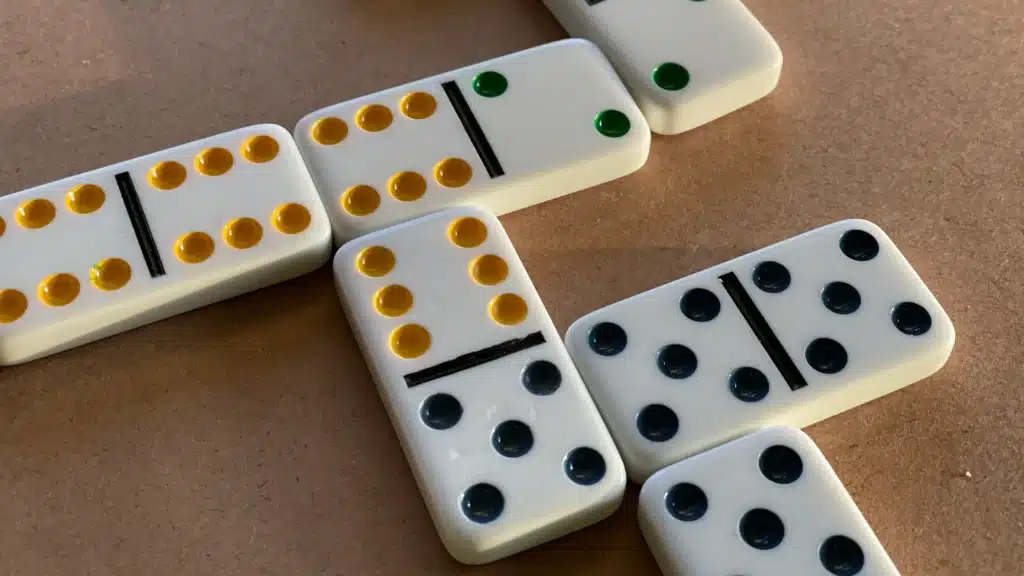Dominoes is a classic game that has been enjoyed by people of all ages for centuries. Its simplicity and versatility make it a perfect choice for family game nights, gatherings with friends, or even just a rainy day activity. If you’re looking to introduce your kids to this timeless pastime, here’s a fun and easy guide to get started.
Table of Contents
ToggleUnderstanding the Basics:
Dominoes is played with a set of rectangular tiles, each divided into two squares. The squares are marked with a series of dots, representing numbers from zero to six. The standard set contains 28 tiles, with each possible combination of numbers represented once.
Setting Up the Game:
- Begin by shuffling the dominoes facedown on a flat surface.
- Each player then draws a certain number of tiles, depending on the number of players:
- For two players: each player draws 7 tiles.
- For three or four players: each player draws 5 tiles.
- The remaining tiles are left face down in the middle to form the draw pile.
- The player with the highest double (a tile with the same number on both squares, such as [6|6] or [5|5]) starts the game by placing that tile in the center of the playing area.
Playing the Game:
Once the first tile is played, subsequent tiles are added to the layout in a line, with each tile touching end to end. A tile can only be placed next to another tile if the two adjacent squares have matching numbers. If a player cannot play a tile, they must draw from the draw pile until they pick a tile they can play. The first player to empty their hand of tiles wins the round.
Tips for Kids:
- Start with Doubles: Doubles are tiles with the same number on both squares. Encourage your kids to play doubles early in the game as they offer more options for building off.
- Plan Ahead: Help your kids think strategically about which tiles to play and which ones to hold onto. They should aim to create opportunities for themselves while blocking their opponents.
- Count the Dots: Dominoes is a great way to reinforce basic counting skills. Encourage your kids to count the dots on each tile as they play.
- Stay Patient: Sometimes the luck of the draw might not be in your favor. Teach your kids to be patient and look for opportunities to turn the game around.
- Have Fun: Most importantly, remind your kids that the goal of the game is to have fun! Whether they win or lose, playing dominoes is a great way to spend quality time together as a family.
Variations to Try:
Once your kids have mastered the basics, consider introducing them to some fun variations of the game, such as:
- Mexican Train: Players work on building their own “trains” of dominoes while also contributing to a central “Mexican Train.” The goal is to be the first to play all your tiles or have the lowest score when someone does.
- All Fives: Players score points based on the total number of dots on the tiles left in their hand at the end of each round. The winner is the player with the lowest total score after playing multiple rounds.
Mexican Train
Mexican Train Dominoes is a popular variation of the classic dominoes game that adds an extra layer of strategy and excitement. It’s typically played with a standard set of double-six dominoes (28 tiles) and can accommodate a varying number of players, usually between two and eight.
Setup:
- Double: The game starts with the “engine” – a double domino, which is a tile with the same number on both ends. The engine can be any double domino agreed upon by the players. For instance, the [12|12] or [6|6] can serve as the starting engine.
- Distribution of Tiles: Each player draws a certain number of tiles from the boneyard (the pool of remaining tiles) depending on the number of players:
- For 2 to 4 players: Each player draws 15 tiles.
- For 5 to 8 players: Each player draws 12 tiles.
- Extras: If playing with more than four players, a train marker (usually a small object like a coin or a token) is placed on each player’s train to indicate their personal train.
Gameplay:
- Starting the Mexican Train: The player with the chosen engine starts the Mexican Train by placing their double domino in the center of the playing area. This becomes the “Mexican Train” and is open for any player to add to during their turn.
- Playing Tiles: On their turn, each player must play a tile that matches the end of any open train. If a player cannot play a tile, they must draw one from the boneyard. If they still cannot play, their turn is skipped.
- Building Personal Trains: In addition to playing on the Mexican Train, players can also start their own “personal train” by playing a tile matching the end of their own train marker. Once started, personal trains are exclusive to the player who started them and can only be added to by that player.
- Markers: If a player is unable to play a tile after drawing from the boneyard, they must place a marker on their personal train to indicate that it’s open for other players to play on.
- Activating the Mexican Train: If a player cannot play on their personal train and opts to open it up to other players, any player can then play on the Mexican Train (the central chain) instead. Once a new tile is played on the Mexican Train, it becomes the active train, and the previous personal train is no longer accessible to other players.
- Ending the Round: The round ends when one player runs out of tiles or when no more tiles can be played by any player. If the round ends because a player runs out of tiles, that player earns points based on the sum of the pips (dots) on the tiles left in the other players’ hands. If the round ends due to a blocked game (no more playable tiles), players tally up the pips on the tiles left in their hands, and the player with the lowest total score wins the round.
- Scoring: The game typically consists of multiple rounds. Players keep track of their scores from round to round, and the player with the lowest cumulative score at the end of the agreed-upon number of rounds is declared the overall winner.
Strategy:
- Blocking Opponents: Players can strategically block their opponents by ending their turn on numbers that are difficult to match.
- Balancing Personal and Mexican Trains: Players must decide when to focus on building their personal train and when to contribute to the Mexican Train.
- Timing: Knowing when to open your personal train to others or when to contribute to the Mexican Train can significantly impact gameplay.
All Fives
“All Fives” is a popular variation of dominoes that adds an extra layer of strategy and scoring to the game. In this variation, players aim to score points based on the total number of dots on the tiles left in their hand at the end of each round. The winner is the player with the lowest total score after playing multiple rounds.
Setting Up the Game:
- Tile Distribution: The game is typically played with a standard set of 28 domino tiles. Players draw a certain number of tiles from the boneyard (the remaining tiles not dealt out initially) to begin the game. The number of tiles each player draws can vary depending on the agreed-upon rules, but a common starting point is 7 tiles for each player in a two-player game, or 5 tiles for each player in a game with three or four players.
- Starting Tile: A tile is placed in the center of the playing area to start the game. This tile can be any double (a tile with the same number on both squares), or it may be specified that only certain doubles can be used as the starting tile.
Playing the Game:
- Building the Layout: Players take turns placing tiles on the layout, following the standard dominoes rules where adjacent tiles must have matching numbers. If a player cannot play a tile, they must draw from the boneyard until they pick a tile they can play. If the boneyard runs out of tiles and a player still cannot play, they must pass their turn.
- Scoring: In All Fives, scoring occurs at the end of each round. Players score points based on the total number of pips (dots) on the tiles remaining in their hand. The goal is to have the lowest possible score.
- Scoring Rules:
- Players score points based on the total number of pips on the tiles remaining in their hand at the end of each round.
- Any leftover tiles with a total number of pips divisible by five (5) score points for the player. For example, if a player has a tile with 3 pips on one end and 2 pips on the other end, they would score 5 points for that tile because the total number of pips is 5.
- A player with a tile containing a double five ([5|5]) scores 10 points.
- If a player goes out (plays all their tiles), they score zero points for that round.
- End of Round: The round ends when one player plays all their tiles or when no more plays can be made. Players then calculate their scores based on the remaining tiles in their hands.
- Winning the Game: All Fives is often played over multiple rounds. The player with the lowest total score at the end of the agreed-upon number of rounds is declared the winner.
Tips for Playing All Fives:
- Strategic Play: Consider playing tiles that will leave you with fewer points at the end of the round. This may involve planning ahead to avoid being stuck with tiles that have high pip counts.
- Pay Attention to the Board: Keep track of which numbers have already been played and try to anticipate which tiles will be most advantageous to play.
- Balance Risk and Reward: Sometimes it’s worth holding onto a tile with a high pip count if it can be strategically used to block opponents or set up a future play that will score you more points.
Dominoes is a timeless game that offers endless possibilities for fun and learning. By following this simple guide and encouraging your kids to get creative, you can enjoy hours of entertainment together as a family. So gather around the table, set up your tiles, and let the games begin!






